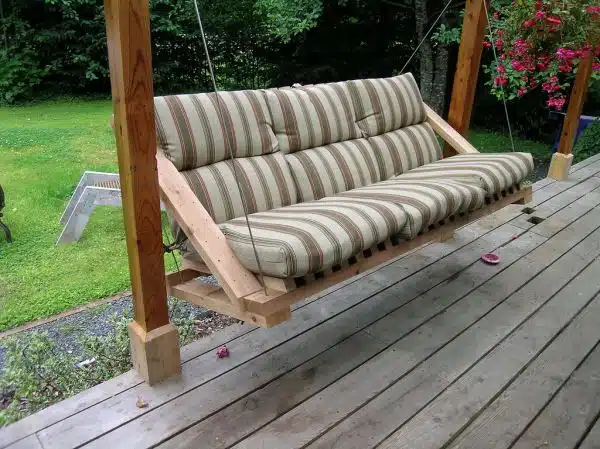The porch swing is a timeless piece of furniture that has been a staple in American homes for generations. A porch swing can add charm and comfort to any outdoor space, providing a cozy spot to enjoy the fresh air and scenery. Building your own porch swing can be a rewarding and cost-effective project that will yield beautiful results.
In this article, we will guide you through the process of building your own porch swing. We will cover the necessary tools and materials, as well as provide step-by-step instructions for constructing the frame, seat, backrest, and armrests. Whether you are an experienced woodworker or just starting out, this guide will help you create a beautiful and functional porch swing that will bring years of enjoyment to your family and guests.
Choosing The Right Wood For Your Porch Swing
Back in the day, porch swings were made from whatever scrap wood was lying around. Nowadays, there are various types of wood that are suitable for building a sturdy and long-lasting porch swing. Popular choices include cedar, cypress, teak, and redwood. These woods are known for their durability and ability to withstand harsh weather conditions.
When selecting your wood for the porch swing project, it’s important to consider factors such as resistance to decay and insects, strength, and weight. Cedar is a popular choice because it’s lightweight yet strong and naturally resistant to decay and insects. Cypress is also a good option because it’s tough and durable but lighter than most hardwoods. Teak is known for its beauty and resistance to moisture while redwood has natural anti-rot properties.
Once you’ve chosen the type of wood you want to use for your porch swing project, you’ll need to decide on how you want it treated. There are several options available including staining, painting or leaving the wood untreated. Staining gives the wood a darker hue while maintaining its natural look while painting allows you to add color without obscuring the grain pattern. Leaving the wood untreated will result in a natural gray patina over time but may make it more susceptible to rotting if not properly maintained.
Measuring And Cutting Your Wood
When constructing a porch swing, it is important to accurately measure the wood, and cut it to the appropriate length, width, and thickness. Power tools such as a saw, drill, and sander, as well as hand tools such as a tape measure, protractor, square, and chisel, are useful for this task. It is essential to use safety gear such as goggles, gloves, and hearing protection when cutting wood. Careful measuring and cutting of the wood is necessary for an effective and aesthetic result.
Measuring
Measuring accurately is one of the most critical steps in building a porch swing. Accuracy is essential as even the smallest mistake can lead to significant issues later on. To ensure precision, it is crucial to use the appropriate measuring tools like a tape measure, combination square, and speed square.
When measuring, it’s important to avoid common mistakes such as relying solely on your eyesight. Estimating measurements can lead to inaccuracies, so it’s best always to double-check with a measuring tool. Additionally, overlooking the importance of taking measurements at right angles can also cause significant issues later on.
Accuracy tips for measuring include marking your measurements clearly and using straight edges when drawing lines. Always take multiple measurements from different angles to ensure accuracy and minimize errors. By following these tips and avoiding common mistakes, you’ll be able to achieve precise cuts that fit together seamlessly during assembly.
Cutting
After measuring the wood accurately, the next crucial step in building a porch swing is cutting. Cutting techniques are essential to ensure that your pieces fit together correctly during assembly. When cutting, it’s important to use the appropriate tools like a circular saw, jigsaw, or handsaw. To achieve precise cuts, it’s best to use a straight edge or guide to help keep your cuts straight and consistent.
Safety precautions are also critical when cutting wood. Always wear protective gear like safety glasses and earplugs to protect yourself from flying debris and loud noise. When using power saws, make sure they are properly grounded and unplugged when not in use. Additionally, it’s important to keep your hands away from the blade at all times and never reach over the saw while it’s running.
To ensure accuracy when cutting, double-check your measurements before making any cuts. Mark your measurements clearly on the wood with a pencil or marker before making any cuts. It’s also best practice to make small cuts first and then gradually work your way up to larger cuts as you gain confidence in your ability. Following these tips will help you achieve precise cuts that fit together seamlessly during assembly of your porch swing project.
Sanding And Finishing Your Wood
After measuring and cutting your wood, it’s time to move on to sanding and finishing your porch swing. This step is crucial for achieving a professional-looking final product. Sanding the wood will remove any rough spots or splinters that could be dangerous or uncomfortable when using the swing. Additionally, finishing the wood with stain or paint will protect it from weathering and extend its lifespan.
There are various staining techniques that you can use depending on your desired outcome and level of experience. One popular method is to apply a coat of pre-stain conditioner, which helps the wood absorb the stain evenly. After letting it dry for a few minutes, you can then apply your chosen color of stain with a brush or rag. Once the first coat has dried completely, you can add additional coats until you achieve your desired shade. Other finishing options include painting the wood or applying a clear coat for added protection.
When choosing your finishing method, consider the climate in which your porch swing will be located and how much maintenance you’re willing to do over time. Staining requires less upkeep than painting but may need to be reapplied more frequently in areas with extreme weather conditions. Whatever method you choose, be sure to follow all safety precautions when working with chemicals and materials.
With your wood sanded and finished, it’s time to move on to creating the frame for your porch swing. However, before diving into this next step, make sure that all surfaces are clean and free of dust and debris from sanding and staining. This will ensure that everything fits together correctly and looks polished once assembled.
Creating The Frame For Your Porch Swing
As important as the swing design itself, the frame of your porch swing must be sturdy and durable. You want to create a structure that can withstand years of use and many seasons of weather. To achieve this, you need to use high-quality materials and excellent craftsmanship in constructing your porch swing’s frame.
When it comes to suspension options for your porch swing, there are several choices available. One option is to use chains, which provide a classic look while being strong enough to support the weight of the swing and its occupants. Another popular option is rope suspension, which provides a softer feel but requires more attention to detail during installation. Whichever option you choose, make sure that it’s secure and rated for the weight capacity you require.
Overall, creating the perfect frame for your porch swing requires careful planning and execution. Take time to research different designs and materials before settling on a final plan. When it comes to suspension options, consider both aesthetic appeal and functionality when making your decision. With these factors in mind, you’ll be able to build a beautiful porch swing that will provide years of enjoyment for yourself and others.
Transitioning into the next section about attaching armrests:
Now that you have constructed a sturdy frame with reliable suspension options, it’s time to focus on adding some functional features that can enhance your comfort while swinging on your porch. Attach armrests on both sides of the seat so that users can rest their arms comfortably while enjoying their leisure time.
Attaching The Armrests
Now that you have built the frame for your porch swing, it is time to move on to the next crucial step – attaching the armrests. The armrests are an essential feature of a porch swing as they provide comfort and support while swinging. Armrest design is critical as it determines how comfortable and functional your porch swing will be.
When designing your armrests, consider factors such as height, width, and shape. The ideal height for an armrest is around 7-9 inches above the seat level. The width should be wide enough to provide ample support but not too wide that it looks bulky or takes up too much space. Curved or angled armrests are more comfortable than straight ones as they conform to the natural position of your arms.
Proper installation techniques are also crucial when attaching the armrests to your porch swing. Generally, you should attach them using screws or bolts after drilling pilot holes to prevent splitting wood. It is advisable to use wood glue in addition to screws for added strength and durability. Make sure the armrests are level and secure before proceeding with building the seat of your porch swing.
In summary, designing and installing armrests correctly can significantly enhance the functionality and comfort of your porch swing. Choose a design that suits your needs and style while ensuring proper installation techniques are followed for maximum safety and durability. With this crucial step completed, you can now move on to building the seat of your porch swing seamlessly.
Building The Seat Of Your Porch Swing
According to a recent study, the design of your porch swing seat can impact the overall comfort and enjoyment of using it. Swing design should take into consideration the weight capacity, width and depth of the seat, and the angle at which it hangs. These factors can all influence how comfortable your swing is to sit in for extended periods of time.
To build a comfortable porch swing seat, consider these three key elements:
Seat dimensions: The width and depth of your porch swing should be large enough to comfortably accommodate the average adult. The standard dimensions for a porch swing seat are between 4-5 feet wide by 2-3 feet deep.
Weight capacity: The weight capacity of your porch swing will depend on the materials used in its construction, as well as its intended use. A basic wooden porch swing can typically support up to 500 pounds, while more heavy-duty models may support up to 800 pounds or more.
Cushion options: Adding cushions to your porch swing can greatly enhance its comfort level. Consider investing in high-quality outdoor cushions that are water-resistant and fade-resistant for long-lasting use.
When constructing the backrest of your porch swing, it is important to keep these design factors in mind to ensure a cohesive and comfortable final product.
Constructing The Backrest
When constructing the backrest for a porch swing, it is important to ensure that the wood is pre-cut to the desired dimensions.
Additionally, the wood should be sanded and stained to create a smooth finish that will be pleasing to the eye.
The backrest should then be securely attached to the frame of the swing, using screws, nails and/or glue.
For additional support, it is recommended to reinforce the joints with a dowel or corner bracket to ensure longevity of the swing.
Preparing The Wood
When it comes to building a porch swing, preparing the wood for the backrest is an essential step. The right wood selection can make all the difference in terms of durability and aesthetics. For this project, it’s best to use a hardwood like cedar or redwood that can withstand outdoor elements. Choose a straight and knot-free board that is at least 1 inch thick and wide enough to accommodate your desired backrest size. To ensure that you have enough wood for the project, calculate your measurements beforehand and purchase extra boards.
Cutting techniques are also important when preparing the wood for the backrest. Use a table saw or circular saw to cut the board according to your measurements. Ensure that all sides are smooth and straight by using sandpaper or a hand plane if necessary. Take care not to over-sand as this may affect the overall thickness of the board.
Once you’ve cut and sanded down your backrest pieces, it’s time to apply staining options and sealing methods. Staining can add color and personality to your porch swing while sealing helps protect it from moisture damage such as rotting or warping. Before staining, ensure that all surfaces are clean and dry by wiping them down with a cloth dampened with mineral spirits. Apply a thin layer of stain using a brush or rag, following the manufacturer’s instructions on drying times between coats. Once you’ve achieved your desired color, apply a sealant which will act as a protective barrier against outdoor elements.
By following these wood preparation steps carefully, you’re well on your way to constructing an attractive and long-lasting porch swing for yourself or others to enjoy.
Attaching The Backrest
Now that the wood for the backrest is prepared, the next step in constructing a porch swing is attaching the backrest itself. Proper attachment is crucial as it ensures stability and comfort. To achieve this, it’s essential to use high-quality hardware such as screws or bolts that can withstand weight and force.
Before attaching the backrest, consider different creative designs that can enhance its comfort level. For instance, adding a curved shape to the top of the backrest can provide better support for the neck and head while swinging. Additionally, incorporating armrests into the design can increase overall comfort levels by allowing for a place to rest your arms.
When attaching the backrest, ensure that it’s properly aligned with the seat of your porch swing and centered between both sides. Use clamps to hold it in place before drilling pilot holes for your screws or bolts. Take care not to over-tighten as this may cause damage or splitting of the wood. Once attached, give your porch swing a test run to ensure that everything feels secure and comfortable.
By following these tips for backrest comfort and incorporating creative designs, you can build a porch swing that not only looks great but also provides maximum relaxation and enjoyment for those who use it. With proper attachment techniques and hardware selection, you can be sure that your porch swing will last for years to come.
Attaching The Backrest To The Frame
The backrest design is a significant aspect of your porch swing’s comfort and aesthetics. It would help if you considered the angle at which it leans back, its height, and its width. A comfortable backrest angle ranges between 15-20 degrees from vertical, while the height should be proportional to the seat’s height. The width should also match the seat’s width or be slightly narrower to ensure it does not interfere with armrests.
Backrest materials can vary depending on your preferences and budget. The most common materials are wood, metal, or plastic. Wood is an excellent option because it is sturdy and can withstand outdoor conditions. Cedar, cypress, teak, and redwood are some of the best wood options for porch swings’ backrests. Metal material is also durable but may require regular maintenance to prevent rusting. Plastic is low-maintenance but may not offer as much durability as other materials.
Now that you have chosen your preferred backrest design and material, it’s time to attach it to the frame. Place the backrest on top of the swing frame and screw it in place using screws that go through both pieces of wood. Ensure that you attach it securely to avoid any wobbling or instability when sitting on the swing. With this step complete, you’re one step closer to completing your beautiful porch swing.
As you move forward in constructing your porch swing, keep in mind that adding decorative touches will make a significant difference in its overall appearance. From colorful cushions to intricate carvings, there are numerous ways to personalize your porch swing and make it stand out in your outdoor space. In the next section, we will explore some creative ways of adding decorative touches to your porch swing without compromising its functionality and safety.
Adding Decorative Touches To Your Porch Swing
When considering ways to add decorative touches to a porch swing, painting can be a great option for adding color and texture to the piece. Embroidery is another popular choice for adding decorative touches, as it can add texture and unique patterns to the swing. Beads can also be used to add texture and color to the swing, with a wide variety of shapes and sizes available. When selecting a technique for decorating a porch swing, it is important to consider the type of wood being used, as different types of wood may require different types of finishes. Additionally, it is important to consider the effects of weather on the swing’s finish, as some finishes may not be as durable in inclement weather. With the right techniques and materials, it is possible to create a beautiful, personalized porch swing.
Painting
Painting is an essential step in adding a decorative touch to your porch swing. Choosing the right color can make a significant difference in the overall appearance of your swing. It is important to consider the color options that will complement your outdoor space and give it a cohesive look.
When it comes to painting techniques, there are several options to choose from. The most popular technique is using a brush or roller, but spray painting can also be used for a smoother finish. Before painting, ensure that the surface is clean and free from any debris. Use sandpaper to smooth out any rough spots and apply primer before painting for better adhesion.
In conclusion, painting is a crucial step in adding decorative touches to your porch swing. By considering color options and using proper painting techniques, you can transform your swing into a beautiful addition to your outdoor space that will provide years of enjoyment.
Embroidery
Adding decorative touches to your porch swing is a great way to enhance its overall appearance. While painting is a popular option, there are other techniques that can be used to achieve the desired effect. One such technique is embroidery, which involves decorating the swing with intricate designs using different thread colors and stitching techniques.
Embroidery techniques can be used to create unique patterns and designs on your porch swing that can complement your outdoor space’s overall theme. The color palettes used in embroidery can also be customized to match or contrast with the existing colors of your porch swing. From floral motifs to geometric shapes, there are endless possibilities when it comes to using embroidery as a decorative touch for your porch swing.
To get started with embroidery for your porch swing, you will need some basic supplies such as an embroidery hoop, needles, threads, and fabric. Once you have gathered these materials, choose a design that you would like to embroider onto your porch swing. You can find inspiration from various sources such as online tutorials or by creating your own design. With patience and practice, you can create beautiful embroidered designs that will add a unique touch of elegance and style to your porch swing.
Beads
In addition to embroidery, adding wooden beads is another way to enhance the decorative appeal of your porch swing. Wooden beads can be used to create intricate and unique designs that add a touch of elegance and sophistication to your swing. There are various types of wooden beads available in different colors, shapes, and sizes that can be customized according to your preference.
To get started with using wooden beads for your porch swing, you will need some basic supplies such as a drill, wire or string, and of course, the wooden beads. The process involves drilling holes in the swing where you want to place the beads and then threading them onto the wire or string. You can create simple or complex beaded designs depending on your skill level and creativity.
Overall, adding wooden beads is an excellent way to personalize your porch swing while also enhancing its visual appeal. Whether you choose simple patterns or intricate designs, incorporating wooden beads into your porch swing will add a unique touch of style that sets it apart from other swings. With a little bit of patience and practice, you can create beautiful beaded designs that transform your porch swing into a stunning work of art!
Installing The Chains Or Ropes For Hanging
When it comes to hanging your porch swing, you have two options: chains or ropes. Chains offer more stability and durability, while ropes give a more rustic and natural look. Choosing between the two depends on your preference and needs.
To hang your porch swing using chains, first decide on the height you want it to be at. Then attach the chains to the hooks on either side of the swing frame, making sure they are even in length. Adjusting the height is easy with chains – just move them up or down on the hook until you achieve your desired level.
If you choose to use ropes instead, make sure they are strong enough to hold the weight of both the swing and its occupants. Tie one end of each rope securely around the top corner of the frame, then thread it through holes drilled in either end of the swing seat. Finally, tie off each rope end in a knot that will not slip or come undone.
- Hang your porch swing from sturdy hooks or eye bolts
- Make sure there is enough clearance around and above it
- Use rust-resistant hardware for outdoor use
- Check for any signs of wear or damage regularly
- Never exceed the weight capacity specified by manufacturer
Now that you have installed your chains or ropes securely, it is time to test their stability and safety before using your porch swing.
Testing The Stability And Safety Of Your Porch Swing
Swing stability is crucial when building a porch swing. The last thing you want is for your swing to be unstable and cause injury to yourself or others. There are several safety tips you should consider when building a porch swing.
Firstly, when choosing the location for your porch swing, ensure that it is installed on a sturdy beam or joist that can support the weight of the swing and its occupants. The beam should be able to withstand the movement of the swing without breaking or bending. Additionally, make sure that there is enough clearance around the swing to prevent any accidents from occurring.
Secondly, check all hardware and connections to ensure they are secure before using the porch swing. This includes checking bolts, screws, chains, and ropes for any signs of wear or damage. If there are any signs of damage, replace them immediately before using the porch swing again.
Lastly, regularly inspect your porch swing for any signs of wear and tear. This includes checking for cracks in the wood or metal frame as well as fraying in ropes or chains. If there are any damages found during inspection, repair them immediately before using the porch swing again.
| Swing Stability | Safety Tips |
|---|---|
| Choose a sturdy beam or joist | Ensure enough clearance around the swing |
| Check all hardware and connections | Replace damaged parts immediately |
| Regularly inspect for wear and tear | Repair damages before use |
In conclusion, ensuring your porch swing is stable and safe is important for preventing injury to yourself and others. By following these safety tips and regularly inspecting your porch swing for wear and tear, you can enjoy swinging on your porch without worry. In the next section we will discuss making adjustments and repairs to your porch swing if needed.
Making Adjustments And Repairs
After testing the stability and safety of your porch swing, it’s important to make any necessary adjustments or repairs before use. One common issue that may arise is the need to adjust the chains. If the swing sits too high or low, adjusting the chains can help achieve a comfortable height for swinging. Simply loosen the bolts attaching the chains to the swing frame and raise or lower as needed before tightening them back up.
Another potential problem area is with seat slats. Over time, these may become loose or cracked, causing discomfort and instability. To repair seat slats, start by removing all slats from the swing frame and inspecting each one for damage. If any are in need of replacement, purchase new slats and attach them using screws or nails according to manufacturer instructions. For loose slats, reattach them securely with new screws or nails.
It’s crucial to ensure that your porch swing is in top condition before enjoying it fully. Taking care to adjust chains and repair seat slats will not only increase comfort but also promote safety. By following these steps, you can be confident in the longevity and functionality of your porch swing.
- Feel secure: Adjusting chains and repairing seat slats will give you peace of mind knowing that your porch swing is safe for use.
- Increase comfort: Proper adjustments will allow for a more comfortable swinging experience.
- Save money: Making repairs yourself can save on costly professional services.
- Enjoy more time outdoors: With a stable and comfortable porch swing, you’ll be able to spend more time outdoors relaxing and enjoying nature.
Now that you’ve made necessary adjustments and repairs to your porch swing, it’s time to choose the right location for it. By selecting an area with ample space and proper support structures, you can ensure both functionality and safety of your swing.
Choosing The Right Location For Your Porch Swing
When it comes to building a porch swing, choosing the right location is crucial. The first thing you need to consider is outdoor decor. Your porch swing should complement the existing style and color scheme of your outdoor space. This will ensure that it doesn’t look out of place or clash with other elements in your yard.
Another factor to consider is comfort versus aesthetics. While you want your porch swing to be visually appealing, it’s important not to sacrifice comfort for style. Make sure the location you choose is comfortable and offers a pleasant view. This will encourage you and your guests to spend more time outside enjoying nature.
Keep in mind that maintenance and care for your porch swing are also essential aspects to consider when choosing its location. Ensure that it’s placed in a spot where it won’t be exposed to harsh weather conditions or direct sunlight for prolonged periods. This will help extend its lifespan and reduce the frequency of repairs and replacements.
Next, we’ll discuss some tips on how to maintain and care for your porch swing so that it lasts for years to come.
Maintenance And Care For Your Porch Swing
After choosing the perfect location for your porch swing, it’s time to focus on its maintenance and care. Regardless of whether you’ve purchased a pre-made swing or built one from scratch, it’s important to know how to properly clean and protect it from harsh weather conditions. Neglecting these aspects can result in damage to the wood, which can be costly to repair.
To keep your porch swing looking its best, regular cleaning is essential. Start by removing any debris or leaves that may have accumulated on the surface by using a soft-bristled brush or vacuum cleaner. Next, use a mild soap solution and warm water to scrub away any dirt or stains. Avoid using harsh chemicals or abrasive materials as this can damage the wood’s finish.
When it comes to protecting your porch swing from weather damage, prevention is key. One of the most effective ways to do this is by applying a sealant or protective oil regularly. This will help repel water and prevent moisture from seeping into the wood, which can cause warping and cracking over time. Additionally, consider investing in a cover for your swing during periods of heavy rain or snowfall.
Now that you know how to properly care for your porch swing, you can enjoy relaxing on it for years to come. By following these simple cleaning instructions and weather protection techniques, you’ll ensure that your handmade creation remains in top condition even after years of use.
Enjoying Your Handmade Porch Swing
Now that you have successfully built your porch swing, it’s time to enjoy the fruits of your labor. The first step towards maximizing comfort is to ensure that the swing is properly installed in a secure location. This can be achieved by following the instructions provided with your swing or seeking help from a professional if necessary.
Once your porch swing is safely installed, you can start thinking about decorating options. Cushions and pillows are an excellent way to add both comfort and style to your swing. Consider choosing fabrics and colors that complement the overall design of your porch and home. You may also want to add some outdoor lighting or plants to create a cozy atmosphere for relaxing.
To truly enjoy your handmade porch swing, it’s important to take some time for yourself each day. Whether you prefer reading a book, meditating, or simply enjoying the fresh air, make sure to carve out some dedicated time for relaxation on your porch swing. By doing so, you’ll not only enhance your own wellbeing but also inspire others around you to prioritize self-care.
- Sink into plush cushions and let all your worries fade away
- Soak up the warmth of the sun while gently swaying back and forth
- Share intimate moments with loved ones while cuddled up close
- Bask in the beauty of nature surrounding you
Remember that building a porch swing isn’t just about creating a functional piece of furniture but also about enhancing your quality of life. By prioritizing comfort and relaxation on your newly built swing, you’ll be able to enjoy countless hours of peaceful bliss in the great outdoors.
Conclusion
When it comes to building a porch swing, choosing the right wood is crucial. From there, precise measurements and cuts are required to create a sturdy frame. Sanding and finishing your wood will ensure a smooth and polished final product. Attaching armrests and making necessary adjustments and repairs will give your swing added comfort and longevity.
Once your porch swing is complete, selecting the perfect location for it to hang will enhance its beauty and functionality. Proper maintenance and care will also prolong the life of your handmade creation. Building a porch swing is not only a practical DIY project but also an opportunity to tap into your creative side and create something unique that you can enjoy for years to come.
As you sit in your new porch swing, swaying back and forth under the stars with a cool breeze blowing through your hair, you’ll feel a sense of pride knowing that you crafted this piece with your own hands. The creaking of the wooden slats against each other will evoke feelings of nostalgia, reminding you of childhood days spent on playground swings or lazy afternoons spent on grandparent’s front porches. A handmade porch swing isn’t just furniture; it’s a memory-making machine that will serve as a gathering place for loved ones as they share stories, laughter, and cherished moments together.
Image Credits
- “Porch Swing” by zieak (featured)

























![How To Repair Rotted Wood 25 Texture : Altario Buick Estate Wagon : Rotting Faux Wood Paneling [1 of 2]](https://green-life.blog/wp-content/uploads/2023/05/z1CersK-gCjq-150x150.jpg.webp)



